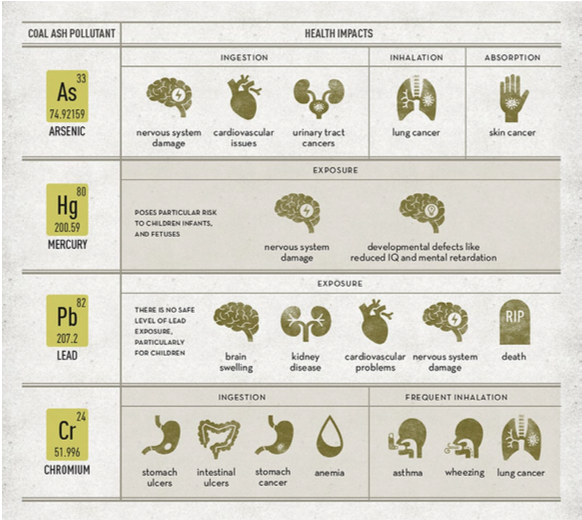.jpg)
Coal power plant located in Muscatine, IA
Coal in Iowa
Ninety-two percent of Iowans live within 30 miles of a coal plant, and almost one out of three Iowa children attend school in close proximity to a coal plant. Additionally, Iowa is home to several of the oldest, least efficient and most polluting coal burning power plants in the nation, those grandfathered and exempted from stricter emissions limits after passage of the Clean Air Act in 1977. This means that not only does Iowa have more power plants per capita than almost all states, but many of Iowa’s power plants emit relatively more pollution per unit of energy produced because of their age. Finally, Iowa also disposes a disproportionate amount of coal combustion waste. Numerous toxic substances naturally found in coal are concentrated in such waste. Iowa has lax regulations on coal combustion waste disposal and allows waste from other states to be brought into Iowa for disposal. Thus Iowa absorbs the waste from its own plants as well as that produced elsewhere despite the potential health and environmental impacts of the many toxic substances involved. Most Iowans, including health care providers and public health workers, are not aware of the intensity of burning coal in Iowa or of coal combustion related health risks. To best serve patients, health care professionals have a responsibility to understand these issues and inform their patients about specific environmental health risks. While health care providers have a duty to prevent disease, they may be unaware of effective measures to reduce or prevent unperceived health risks.
Download Iowa Coal & Health: A Preliminary Mapping Study
View the Executive Summary View the Full ReportCoal Combustion Waste (Coal Ash)
Living near a coal-burning power plant poses major health risks. Studies link coal-derived particulates, including those from fly ash, to the four leading causes of death in the United States: heart disease, cancer, respiratory diseases and stroke.
The components of coal ash include countless toxic metals; arsenic, mercury, chromium, lead, uranium, selenium, molybdenum, antimony, nickel, boron, cadmium, thallium, cobalt, copper, manganese, strontium, thorium, vanadium and others. Additionally, coal ash contains radioactive material such as uranium, thorium, potassium and radium. When the particulate matter containing radioactive material is inhaled, it is absorbed into the lungs and will undergo radioactive decay potentially replacing calcium in the person's bones.

Health Impacts of Coal Energy: Image taken from Ash in the Lungs: How Breathing Coal Ash is Hazardous to your Health (Lockwood, A & Evans, L.)
Coal Ash Report
Summary of HAZARDOUS AND SOLID WASTE MANAGEMENT SYSTEM; DISPOSAL OF COAL COMBUSTION RESIDUALS FROM ELECTRIC UTILITIES
The Environmental Protection Agency (EPA or the Agency) is publishing a final rule to regulate the disposal of coal combustion residuals (CCR) as solid waste under Subtitle D of the Resource Conservation and Recovery Act (RCRA). The available information demonstrates that the risks posed to human health and the environment by certain CCR management units warrant regulatory controls. EPA is finalizing national minimum criteria for existing and new CCR landfills and existing and new CCR surface impoundments and all lateral expansions consisting of location restrictions, design and operating criteria, groundwater monitoring and corrective action, closure requirements and post closure care, and recordkeeping, notification, and internet posting requirements. The rule requires any existing unlined CCR surface impoundment that is contaminating groundwater above a regulated constituent’s groundwater protection standard to stop receiving CCR and either retrofit or close, except in limited circumstances. It also requires the closure of any CCR landfill or CCR surface impoundment that cannot meet the applicable performance criteria for location restrictions or structural integrity. Finally, those CCR surface impoundments that do not receive CCR after the effective date of the rule, but still contain water and CCR will be subject to all applicable regulatory requirements, unless the owner or operator of the facility dewaters and installs a final cover system on these inactive units no later than three years from publication of the rule. EPA is deferring its final decision on the Bevill Regulatory Determination because of regulatory and technical uncertainties that cannot be resolved at this time.
View the Full Prepublication ReportPSR's Response
Physicians for Social Responsibility supports EPA’s efforts to protect human health and the environment via the protections called for in its proposed rule: Carbon Pollution Emission Guidelines for Existing Stationary Sources: Electric Utility Generating Units, also known as the Clean Power Plan. However, we recognize that these steps will not be sufficient to provide the protections from climate change that current and future generations deserve. We recognize that other stakeholders will have conflicting positions. We are concerned that those who oppose the rule and any effort to regulate carbon dioxide emissions have not heeded the abundant evidence presented in the scientific and medical literature for the public health impact of climate change. The science is solidly in support of our call for reductions in carbon dioxide emissions.View PSR's Full Response to the EPA's Hazardous and Solid Waste Management System